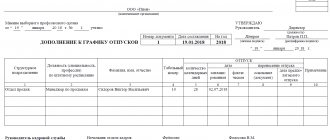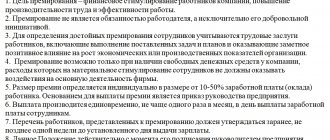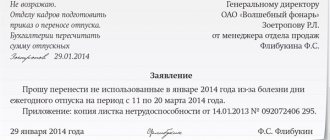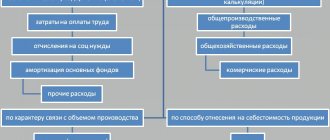Is it possible not to draw up a wage regulation and can they be punished for this?
The wage regulations are one of the employer’s internal documents.
It is necessary not only to describe the applied system of calculation and remuneration for labor, but also to consolidate the system of material incentives and rewards for employees in the organization. This provision justifies the legality of including salary costs in tax expenses. Its absence sharply reduces the chances of proving to tax authorities the legality of reducing the tax base for income tax or the simplified tax system for bonuses, additional payments, compensation and other similar payments.
Find out whether the employer is obliged to pay a bonus by following the link.
Given these advantages of the provision, taxpayers in most cases spare no time and effort in developing it.
You can do without such a document only in one case - if all the terms of remuneration are described in employment contracts with employees or in a collective agreement, or all employees of the company work under conditions that exclude any deviations from the usual (do not work overtime, at night and on holidays ). In this case, there is no need to draw up a separate provision.
The legislation of our country does not contain an unconditional requirement to develop and apply wage regulations for each employer. There are no requirements for the form, type and content of this document. Therefore, there will be no punishment for the arbitrary form of the provision or its absence as a separate document.
And if changes are made to working conditions, disputes may arise with both employees and workers. Find out how to correctly approve the wage regulations and avoid claims from a consultation with an expert from the Ministry of Labor. To do this, go through a quick registration in the ConsultantPlus system and get trial access for free.
Regulations on remuneration and bonuses for employees: is it necessary to combine
Since there are no legal requirements on this issue, in different companies you can find a variety of options for drawing up internal documents related to the calculation and payment of wages to employees.
For example, the regulations on wages are drawn up as a separate document, and the conditions for bonuses are prescribed in another local act - the regulations on bonuses and material incentives for employees. It is possible to provide for other salary provisions: on wage indexing, summarized recording of working hours, etc.
Some employers are limited to approving only one document - a collective agreement, which stipulates all the necessary aspects of the salary policy.
Read about the purpose and features of a collective agreement in the material “Collective agreement as a form of social partnership.”
The decision on whether to prescribe all the necessary salary nuances in one document or formalize each significant issue in separate provisions remains with the management of the company or the employer-individual entrepreneur. If a decision is made to combine the issues of the payment system and the features of bonuses in a single provision, it is necessary to spell out all the nuances in this document as scrupulously as possible.
To learn about what bonuses and rewards can be for employees, read the article “What are the types of bonuses and rewards for employees?” .
Who should make the position
Local regulations on the calculation and payment of wages are necessary for business entities if they have labor contracts with employees.
Regulations on remuneration of employees are not necessarily developed at the enterprise. This is primarily due to the fact that the issues discussed in it may be reflected in other regulations at the enterprise - Collective Agreement, Internal Regulations, etc.
According to the Labor Code of the Russian Federation, the very fact of specifying the current legal norms to the specific operating conditions of an enterprise should be mandatory, since standards often establish several options for action in certain conditions. This is especially important when regulating issues of remuneration for periods that differ from normal working conditions.
Therefore, which act will reflect the rules for calculating wages is decided by the management of the enterprise independently.
Attention! Combining regulations in one document is typical for small businesses. In practice, for example, the Labor Regulations are often combined with the rules governing the calculation of all types of bonuses. Then this document is called the Regulations on remuneration and bonuses for employees.
The larger the business entity, the more it has its own standards. At the same time, it is imperative to ensure that they are consistent and do not contradict each other. Many issues regarding the regulation of wages can be immediately addressed in several provisions of the enterprise. If there is any discrepancy among them, this will lead to their invalidation.
You might be interested in:
Local regulations of the organization: what are they, list of basic documents
Local regulations at the enterprise are developed by specialists from the economic and legal departments. The project is submitted for approval to representatives of trade union bodies before approval.
Main sections of the regulations on remuneration and bonuses for employees
The regulations on wages and bonuses for employees may include, for example, the following sections:
- general terms and definitions;
- description of the current form and wage system in the company;
- terms and forms of salary payment;
- employer's liability for delayed wages;
- duration of the provision;
- “Additional payments” table;
- “Compensation” table;
- table "Allowances";
- “Premiums” table;
- table “Other employee benefits”.
The general section provides a link to the regulatory documents in accordance with which this provision was developed. Then a decoding of the basic concepts and terms used in the provision is given, so that any employee, when reading it, would not have difficulty understanding the contents of the document. The same section indicates who this provision applies to (employees under an employment contract, part-time workers, etc.).
The second section is devoted to a description of the wage system (WRS) adopted by the employer (time-based, piece-rate, etc.). If different SOTs are provided for different categories of workers and employees, a description of all applicable systems is given.
The section intended to describe the terms and forms of salary payment indicates the dates for the payment to employees of their earned remuneration (advance payment and final payment). You cannot limit yourself to a one-time payment of salary income.
See also “Advance payment – what percentage of salary?” .
IMPORTANT! Remuneration for labor must be paid at least 2 times a month (Part 6 of Article 136 of the Labor Code of the Russian Federation, letter of Rostrud dated May 30, 2012 No. PG/4067-6-1). Violators of this requirement may face administrative liability under clause 6 of Art. 5.27 of the Code of Administrative Offenses of the Russian Federation (fine from 30,000 to 50,000 rubles for a company, from 10,000 to 20,000 rubles for its officials and from 1,000 to 5,000 rubles for individual entrepreneurs). Also keep in mind that the payment period must be determined by a specific date; you cannot create a “fork” of dates.
However, paying wages more than 2 times a month will not violate any norms. Read more about this in the material “Salaries can be paid more than twice a month .
The same section reveals the form of remuneration: in cash through a cash register or by transfer to employees’ bank cards, as well as the percentage of possible payment of part of salary income in kind.
A separate paragraph reflects information related to the employer’s responsibility for delayed wages.
IMPORTANT! The employer's financial liability for delayed wages is provided for in Art. 236 of the Labor Code of the Russian Federation, which sets the minimum interest rate (not lower than 1/150 of the refinancing rate of the Central Bank of the Russian Federation from amounts not paid on time for each day of delay).
The regulations may establish an increased amount of compensation.
The main text part of the provision ends with a final section, which indicates the period of its validity and other necessary conditions.
Tabular part of the position
In the structure of the position from the example considered, all additional payments, compensations and bonuses are placed in separate tabular sections. This is not necessary - the text form of presentation can also be used. In this case, this method of structuring information was used for the purpose of clarity and ease of perception.
For information about what payments form the remuneration system, read the article “Art. 135 of the Labor Code of the Russian Federation: questions and answers" .
The “Additional payments” table contains a list of those salary supplements that are applied by the employer. For example, these could be additional payments related to overtime work, for night work or the employee’s work on a holiday, and other additional payments.
For each type of additional payment, the corresponding interest rates are indicated in the table. For example, for night work the surcharge is 40% of the hourly rate (for hourly workers). The necessary explanatory data is indicated in a separate column of the table (it may be called “Note”). For example, for additional payment for night work, this column shows the period considered night: from 22:00 to 6:00.
The structure of the “Compensation” table is similar to that described above. The listed compensations (for example, for harmful and dangerous working conditions, upon dismissal, reduction, etc.) are supplemented with the corresponding amount or calculation algorithm.
The “Additions” table is present in the regulations only if this type of monetary supplement to the employer’s salary exists. An example is the bonus for length of service. In this case, it is necessary to explain in detail for what period what amount of the premium is due. For example, for work experience from 4 to 7 years, the salary increase will be 12%, from 7 to 10 - 15%, and over 10 years - 18% of the accrued salary.
The remaining tables are filled in the same way.
You can see and download a sample regulation on remuneration and bonuses for employees - 2020 (current for 2021) on our website using the link below:
Types of cash incentives
The regulation includes an important section on monetary incentives for employees. It must indicate all current types of compensation and allowances with a specific indication of their amounts and payment procedure (in which cases they are applied and in what amount). The reward system may include the provision of free trips, tickets, etc. - then information about this is included in the document. In the “Financial assistance” section you need to indicate a complete list of cases when the administration provides financial support to its employees. This list usually includes: the birth of a child, the loss of a close relative, marriage. We can also talk about the case of individual assistance based on specific circumstances.
Additional items can be added if desired. If you decide to use a sample employee remuneration regulation 2021 prepared by experts, you should carefully double-check it for compliance with the procedures of your organization and rework it: for example, in some places there are allowances, and in others there are not. Some set a limit on the total amount of additional payments, others do not limit them.
It is necessary to indicate the specific amount of financial assistance or the method for determining it. For example, the director establishes it by his own decision in a separate order based on the submission of the employee’s immediate supervisor. This paragraph also separately indicates whether amounts of financial assistance will be taken into account when calculating average earnings.
Is it necessary to review the wage regulations every year?
The wage regulations can be approved by the employer once and be valid without a time limit (indefinitely). The legislation does not establish any specifics for the validity period of such a document.
The need for an annual review of the regulations may arise in cases where the employer is developing new types of activities involving workers of various professions, for which a revision or addition of existing SOT and incentive payments is necessary, or working conditions are changing.
The employer and employees are interested in keeping their internal local acts up to date and must promptly initiate their revision, including the provisions under consideration.
We will tell you what to indicate in the order approving the wage regulations here.
What nuances are provided for in the provision for piecework wages?
Piece wages are one of the forms of remuneration in which the amount earned depends on the number of units of product produced by the employee or the amount of work performed. This takes into account the quality of the work performed, the complexity of execution and working conditions.
There are several types of piecework wages:
- simple;
- piecework-bonus;
- chord.
It is based on piece rates, and other salary supplements (for example, a bonus for absence of defects) are set as a fixed amount or as a percentage of the amount earned.
Depending on the types of piecework wages used, the regulations provide for the specifics of calculating and paying wages, taking into account all the nuances of a given SOT for a particular employer.
Read more about the piece-rate and bonus payment system in the material “The piece-rate and bonus payment system is...” .
Find out how an organization can switch to a new remuneration system in the ready-made solution ConsultantPlus.
Position on piecework wages
___________________________________________________________ (full name, address, OGRN, INN of the employer) “AGREED” I APPROVED Employee Representative ________________________ (trade union body) (manager position) _____ “________________” _____ “________________” ________________________ ________________________ (signature, M.P.) (signature, M. P.) “__”____________ ____ g. “__”____________ ____ g.
Position on piecework wages
GENERAL PROVISIONS
1.1.
This Regulation on the procedure for remuneration and incentives for work under the piecework system (hereinafter referred to as the “Regulations”) in ____________________ (hereinafter referred to as the “employer”) was developed in accordance with Section VI of the Labor Code of the Russian Federation and other regulatory legal acts of the Russian Federation. 1.2. The piecework system is used by the employer to pay for the following types of work:
______________________________________________________________________________; ______________________________________________________________________________; ______________________________________________________________________________. (types of construction, mechanical engineering, agricultural, etc. work, where the finished result can be obtained only in the process of completing a complex of technological and production operations, as a rule, over several reporting periods - months, quarters)
The list of positions and specific employees transferred with their consent to piecework payment is approved by the employer in the form of an order before the beginning of the period from which it is subject to application in relation to such positions and employees.
This list may be changed at any time by agreement of the parties to the labor relationship. If the parties disagree, changes are made in accordance with Ch. 12 of the Labor Code of the Russian Federation.
1.3. The employer finances the costs of paying remuneration in accordance with Art. 255 of the Tax Code of the Russian Federation.
1.4. Piece-rate remuneration - where remuneration (wages and bonuses) is accrued to the employee based on the actual, quantitative and materially measurable results of his work, which is an incentive for the employee to increase labor productivity and reduces the employer’s costs for monitoring the appropriateness of the employee’s use of working time.
With an individual direct piecework wage system, remuneration is paid for the actual volume of work performed at individual prices (internal prices), taking into account the tariff rate and the quality of the work performed.
With a collective piecework-bonus system of remuneration, the amount of remuneration paid depends on the actual qualitatively performed and delivered on time to the employer or customer, quantitatively and materially measurable results of work, completed production operations, etc.
1.5. The official salary is paid by the employer in accordance with the staffing table and represents a fixed amount of remuneration to the employee for the performance of labor (official) duties of a certain complexity for a calendar month, excluding compensation, incentives and social payments, including under this Regulation.
1.6. The average monthly total remuneration payments under this Regulation cannot be less than the official salary.
1.7. The employer issues a task to the team (for individual tasks - to the employee) that has switched to remuneration according to these Regulations, which provides for planned indicators and determines the deadlines for the delivery of completed work, breaking it down into separate stages, if necessary.
1.8. The task is considered at a general meeting of the team and is clarified taking into account the proposals made to increase the technical level and economic efficiency of the work performed, reduce labor intensity and reduce the number of employees, reduce the deadlines for completion and delivery of results to the employer or customer. Based on these proposals, the employer makes the necessary changes to the task, approves it and establishes a schedule for completing the work as a whole or its individual stages (works).
When adjusting a task for reasons beyond the control of the performers (crew or employee), as well as current prices and standards, the approved tasks are adjusted by agreement of the parties.
1.9. The assessment of the implementation of the calendar plan for the corresponding period is carried out by the employer together with the team leader (for individual tasks - by the employee). This takes into account:
— compliance with work deadlines, confirmed by reporting (delivery) documents;
— quantitative indicators of the work performed, their compliance with established technical and economic indicators;
— quality of work;
— participation of each employee in the performance of work.
INDICATORS FOR CALCULATION OF WAGES AND BONUSES
2.1. The calculation basis for piecework wages is the tariff rate, which represents the amount of remuneration to be paid to the employee for participation in the production (or production, construction, execution) of a unit of product (finished product, completed object, certain business transaction). The tariff rate is _____ (__________) rubles.
The piecework tariff rate (price), as well as the production rate for identical products and operations performed under the same conditions, are the same for all workers.
2.2. The basic coefficient of labor participation (KTUbas.) of any employee is equal to 1 and is a multiplier for determining the amount of remuneration of each employee for participation in the production (or production, construction, execution) of a unit of product (finished product, completed object, certain business operation) under normal conditions. conditions. KTUbase. adjusted upward or downward depending on the application of increasing or decreasing coefficients related to the job responsibilities of a particular employee in accordance with the List attached below. This List includes a mandatory minimum list of factors, but each structural unit (team, workshop, etc.) can supplement this List in order to provide greater detail and take into account its own operating conditions.
2.3. Lists of indicators taken into account when determining the KTU of an individual employee:
2.3.1. Table No. 1 - increase.
————————————————————————— ¦ Factors influencing the increase in the coefficient ¦ Magnitude ¦ ¦ ¦ increase ¦ +—————————— ———————————+———+ ¦Employee qualifications (special education, rank in specialty, special skills, etc.) ¦ ¦ +————————— ————————————+———+ ¦The complexity of the work performed ¦ ¦ +—————————————————————+———+ ¦Amount of work performed ¦ ¦ +—————————————————————+———+ ¦Quality of work performed ¦ ¦ +—————————— ———————————+———+ ¦Conditions of the work performed (climatic, special, harmful, etc.), not compensated from other sources ¦ ¦ +—————— ———————————————+———+ ¦Rationalization proposals, copyrights applied in the work performed (patents, programs, inventions, know-how, etc. .), innovations ¦ ¦ +—————————————————————+———+ ¦Trouble-free operation ¦ ¦ +—————————— ———————————+———+ ¦Environmentally friendly work performed ¦ ¦ +—————————————————————+———+ ¦Reduction in production costs by no less than __ percent¦ ¦ ¦from ______________________ ¦ ¦ +—————————————————————+———+ ¦Increase in profitability against the planned level no less than ___¦ ¦ ¦percent ¦ ¦ +—————————————————————+———+ ¦Mentoring ¦ ¦ +——————— ——————————————+———+ ¦For the introduction of rationalization proposals that do not yet have ¦ ¦ ¦economic effect ¦ ¦ +—————————————— ———————+———+ ¦For performing managerial functions ¦ ¦ +—————————————————————+———+ ¦For length of service ¦ ¦ +—————————————————————+———+ ¦Other indicators ¦ ¦ ———————————————— —————-+———-
2.3.2. Table No. 2 - reduction.
————————————————————————— ¦ Factors influencing the decrease in the coefficient ¦ Magnitude ¦ ¦ ¦ decrease ¦ +—————————— ———————————+———+ ¦ 1 ¦ 2 ¦ +—————————————————————+———+ ¦Untimely going to work resulting in a violation of the production schedule. ¦ ¦ ¦Violation of work deadlines ¦ ¦ +—————————————————————+———+ ¦Violation of technology that did not result in defects or damage to raw materials, ¦ ¦ ¦ materials, excessive energy consumption ¦ ¦ +—————————————————————+———+ ¦Violation of rules for the operation of communications equipment, office equipment, ¦ ¦ ¦computers ¦ ¦ +— ————————————————————+———+ ¦Violation of safety and fire safety regulations: ¦ ¦ +—————————————— ———————+———+ ¦evading the next briefing ¦ ¦ +—————————————————————+———+ ¦using faulty equipment and tools ¦ ¦ +—————————————————————+———+ ¦violation of instructions before starting work ¦ ¦ +————————— ————————————+———+ ¦violation of instructions during operation ¦ ¦ +—————————————————————+— ——+ ¦violation of the requirements of instructions upon completion of work ¦ ¦ +—————————————————————+———+ ¦Unsatisfactory technical condition of the entrusted ¦ ¦ ¦technological equipment ¦ ¦ +—————————————————————+———+ ¦Presence of disciplinary sanctions: reprimand, reprimand, severe ¦ ¦ ¦reprimand ¦ ¦ +————— ————————————————+———+ ¦Violation of labor discipline: ¦ ¦ +—————————————————————— +———+ ¦being late ¦ ¦ +—————————————————————+———+ ¦appearing drunk, in a state of drug intoxication, ¦Full ¦ ¦ absenteeism ¦ deprivation ¦ +—————————————————————+———+ ¦Loss of a product (object, etc.) due to the fault of the team ¦Complete ¦ ¦ ¦ deprivation ¦ +—————————————————————+———+ ¦Presence of justified claims based on the results of work from the side¦ ¦ ¦customers (clients) ¦ ¦ +—— ———————————————————+———+ ¦Identification of shortcomings in the work result during the ¦ ¦ ¦guarantee period ¦ ¦ +——————————— ——————————+———+ ¦Identification of shortcomings in the work result after the expiration of the ¦ ¦ ¦guarantee period ¦ ¦ +———————————————————— —+———+ ¦Untimely, poor-quality or unreliable ¦ ¦ ¦presentation of reports ¦ ¦ +—————————————————————+———+ ¦Violation of administration accounting, resulting in losses, ¦ ¦ ¦ with compensation for losses in accordance with the Labor Code of the Russian Federation ¦ ¦ +—————————————————————+———+ ¦Untimely and poor quality planning and bringing ¦ ¦ ¦ control figures to the performer ¦ ¦ +——————————————————————+———+ ¦Failure to comply with the instructions of regulatory authorities ¦ ¦ +——— ——————————————————+———+ ¦Untimely execution of documents ¦ ¦ +———————————————————— —+———+ ¦Violation in record keeping ¦ ¦ +——————————————————————+———+ ¦Weak preventive work on labor protection and technology ¦ ¦ ¦safety, the presence of industrial accidents and accidents ¦ ¦ +—————————————————————+———+ ¦Violation of the procedure for using personal protective equipment ¦ ¦ + —————————————————————+———+ ¦Other indicators ¦ ¦ ——————————————————— ——-+———-
2.4. With collective (team) wages, the wages of the entire team are set taking into account the actual work performed and its price, and the wages of each employee of the team (team) depend on the volume of products produced by the entire team and on the quantity and quality of his work in the total volume of work.
2.5. The basis for calculating remuneration is data from accounting and statistical reporting, and for indicators that are not provided for in accounting and statistical reporting - operational accounting data.
2.6. The funds provided in the task for paying wages to employees of the unit (team) are used in the following areas:
2.6.1. To prepay wages before delivery of the work result and receive proceeds from its subsequent sale.
The amount of prepayment is determined for each job based on the technical and economic level of the work performed.
2.6.2. To establish premiums to tariff rates for the period of execution of work or for another period, depending on the quality of work, the actual reduction in the time of their implementation and the achieved reduction in labor intensity.
2.6.3. To encourage employees.
The distribution of funds according to the areas of their expenditure is determined by the general meeting of the brigade.
2.7. Wages are paid at least every half month on the day established by the internal labor regulations, collective agreement, or employment contract.
2.7.1. For the first half of the month, an advance payment is made against wages. The amount of the advance must not be lower than the tariff rate for the time worked.
2.7.2. When determining the amount of the advance, the time actually worked by the employee (actually completed work) is taken into account.
2.8. The bonus is accrued based on the results of delivery of the work result and upon receipt of proceeds from the sale of the work result. The distribution of these funds is made among employees directly involved in the implementation of this task.
2.8.1. After delivery to the customer of the result of work that meets the requirements stipulated in the approved task, the team (employee) is paid the funds remaining after payments in the form of wages, based on the planned price of the product (object, result of work).
2.8.2. If it is impossible to deliver the result of work for reasons beyond the control of the team (for individual tasks - from the employee), the bonus for delivery of the result of work is paid within the planned time frame and at the planned price.
2.8.3. After receipt of proceeds from the sale of a product (object, result of work), bonuses are paid in the amount specified in the task.
2.8.4. If it is impossible to realize the result of work for reasons beyond the control of the team (for individual tasks - from the employee), the bonus for implementation is paid based on sales at the planned price.
2.9. To compensate for losses on claims of customers (clients), perform warranty work and post-warranty service, the employer creates a guarantee fund in the amount of _____ percent of the cost of the work result (product, object). At the expense of the team (for individual tasks - the employee), _____ percent of the cost of the work result (product, object) is transferred to the guarantee fund.
2.10. Employees dismissed before the bonus was paid, regardless of the reason for dismissal, with the exception of those dismissed on the basis of clauses 5 - 7, 9 - 11, part 1, art. 81 of the Labor Code of the Russian Federation, bonuses are awarded according to planned indicators for actual time worked.
2.11. For newly hired employees, bonuses are awarded for work actually completed.
2.12. If deficiencies, errors and miscalculations are discovered in the submitted or implemented work (product, object), they are eliminated without additional payment. Employees who made mistakes that resulted in losses to customers bear personal liability in accordance with current legislation.
TERMS OF PAYMENT AND BONUSES
3.1. Accrued wages are paid to each employee at least every six months on the day established by the internal labor regulations, collective agreement, or employment contract.
3.2. The accrued bonus is paid on paydays.
OTHER PROVISIONS
4.1. Remuneration paid under this Regulation for non-working holidays on which employees were involved in work is recognized as an expense in the amount accrued, actually paid and reflected in the employment contracts.
Head of HR Department: _________/__________/
Head of Labor and Payroll Department: _________/__________/
I have read this Regulations _________/__________/
Results
Regulations on wages are necessary for both employees and the employer. With the help of this internal document, it is easier for the taxpayer to defend to the tax authorities the validity of reducing the tax base for income tax or the simplified tax system for various salary payments. And employees will be confident that they will not be deceived when calculating their salaries and they will be able to receive legal bonuses and compensation (including through legal proceedings).
This document does not have a legally established form; each employer has its own form.
Its validity period is set by the employer independently. The provision may be revised as necessary or remain in effect indefinitely. You can find more complete information on the topic in ConsultantPlus. Free trial access to the system for 2 days.
What it is
Regulations on remuneration of workers - a local regulatory act that includes the features, procedure and terms of payment of wages, wage systems established in the organization, mechanisms for calculating wages, the procedure for indexing and other significant issues related to the calculation and payment of all types of employees benefits, financial assistance, compensation, etc.
The wage regulation is not a mandatory document and its absence does not threaten the employer in any way, but in general it significantly makes life easier for both the employer and his employees.
The regulations do not have a unified form and are drawn up by each employer independently, taking into account legal norms and the specifics of the organization’s activities (IP).









